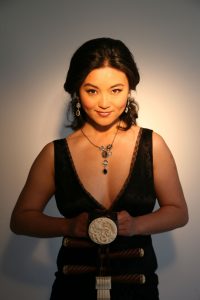Tan Dun’s Ghost Opera Haunts San Diego Museum of Art
Life and death. The really big topics. Once religion had the monopoly on this conversation, but in our essentially secular culture, the arts increasingly carry on the discussion.
Art of Élan staged Tan Dun’s evocative, recondite “Ghost Opera” Tuesday (Nov. 20) at the San Diego Museum of Art’s Copley Auditorium, the second installment on the company’s avant garde series “in your dreams.” A theater piece that weaves aspects of ancient Chinese funeral rites with the warm sounds of the string quartet and the piquant edge of the pipa (a traditional Chinese lute), “Ghost Opera” creates an esoteric but mesmerizing 40-minute ritual.
“Ghost Opera” starts with the strings quoting softly the opening of J.S. Bach’s Prelude and Fugue in C-sharp Minor (BWV 849) while the pipa player intones a fragile, traditional Chinese folk song; later, a snippet of Shakespeare’s “Tempest” is recited in fragments. These three elements, according to the composer, represent the past. The string quartet and the pipa represent the present, and the sounds of stones, paper and water (those who attended Tan Dun’s “Water Passion” at SummerFest 2012 in August know how important illuminated bowls of water are to the composer) represent eternity. As these elements comingled in various combinations and textures, friendly spirits were conjured with plaintive wails; demons were routed with fierce shouts, and the walls that separate past and future were penetrated.
The Hausmann Quartet, a resident ensemble at San Diego State University, and pipa virutosa Jie Ma gave a riveting, sympathetic account of this 1994 piece originally written for (and recorded by) San Francisco’s Kronos Quartet and Wu Man. Not only are the “Ghost Opera” musicians required to move around the stage, sometimes playing as they stride, they must also play various percussion instruments (bells, gongs, cymbals, rocks), and the single-stringed lute, as well as occasionally sing and frequently shout “Yao,” a Chinese exclamation that startles demonic powers.
Perhaps the most significant aspect of Tan Dun’s musical language is his use of time. Western composers use rests in varying[php snippet=1] degrees, but rarely without loosing the underlying pulse. Tan Dun often abandons continuous pulse, suspending the forward direction, making the movement from instrument to instrument or from one musical idea to the next unpredictable. The listener is engaged more by the actions and movements of the performers than by the flow of the music, which is why “Ghost Opera” is more ritual than string quartet with obbilgato lute.
To that end, members of Hausmann and Jie Ma proved masterful. First violin Isaac Allen protrayed a ferocious monk pantomime; second violin Eric Chin played confidently while striding around the stage, and cellist Jeremiah Shaw executed precise hand percussion patterns when not encumbered with his instrument. Jie Ma sang delicately while punctuating her phrases with deft finger cymbals.
This is the first time I have heard the Hausmann Quartet, and I was favorably impressed with their beautifully matched ensemble in the quiet sections of this work. I imagine them playing a delicious Ravel F Major String Quartet or Janacek’s “Intimate Letters.” I was also impressed with the massive, rich sonority that violist Angela Choong poured out in the opening movements as a kind of pedal tone around which the other elements gathered.
Jie Ma’s pipa solos bristled with an articulate, singing tone, and she turned tartly percussive beginnings into deftly shaded resolutions. I prescribe listening to the pipa for those who—like me—who have heard one too many Rodrigo guitar concertos.
This program opened, appropriately, with Ines Irawati’s serenely balanced account of the Bach C-sharp Minor Prelude and Fugue that “Ghost Opera” quotes. Her keyboard technique was admirable, although the harpsichord on which she performed was the most bland, feeble harpsichord I have ever encountered in a concert.
Violinist Pei-Chun Tsai offered Bright Sheng’s “The Stream Flows,” a taut, asymmetrical pair of contrasting portraits for solo violin. The relaxed, sinuous melody of the first, tempered by frequent bent tones, contrasted well with the throaty, raucous peasant dance of the second. Sheng, another Chinese composer who has found acclaim in North American musical circles, is particularly skilled at fusing Asian musical gestures into tonal musical contexts. It made a winning prelude to ¨Ghost Opera.”
[box] Art of Élan performs at San Diego Museum of Art, Balboa Park
Ines Irawati, harpsichord
Pei-Chun Tsai, violin
The Hausmann String Quartet
Jie Ma, pipa
Tickets: $20 – 25; 619.692.2081
www.artofelan.org
Next program: dreams and travels, 5 March 2013[/box]

